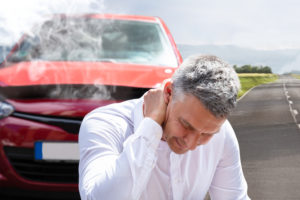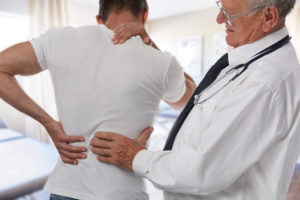
A back injury can result in chronic or recurring pain that interferes with your ability to work or participate in the activities you enjoy. The most severe cases might even disable you to the point where you need a caretaker to help you with your daily needs.
Back pain is the most common cause of missed work days. When you add up the medical expenses from treating back injuries with the lost productivity from back pain, these kinds of injuries cost the U.S. economy over $12 billion per year.
Consider these facts about back injuries and the compensation you can seek when you suffer a back injury in an accident.
What Is the Anatomy of Your Back?

Your back is composed of several structures that give it strength, stability, and movement. It must carry your weight and hold your body upright when sitting, standing, and walking. At the same time, it must provide the flexibility for you to lean, bend, and twist.
The spine runs through the center of your back. It’s made up of 24 vertebrae, which doctors divide into three sections based on their location and purpose.
At the top of your spine, seven cervical vertebrae form your neck. These vertebrae support the weight of your head and protect the spinal cord as it exits the skull and begins its path down your back.
In the middle of your spine, you have 12 thoracic vertebrae. Ligaments hold 12 pairs of ribs to these vertebrae. The thoracic vertebrae support your body and help to form your rib cage.
Five lumbar vertebrae sit at the base of your spine. These vertebrae support the weight of nearly your entire body, transferring the weight to your hips so you can walk upright.
Between each pair of vertebrae sits a disc composed of a fibrous annulus and a soft nucleus. The annulus and nucleus cooperate to act as shock absorbers, cushioning your spine when you stand, walk, and jump. The discs themselves have smooth, tough surfaces so that your vertebrae can move smoothly when you twist or bend.
Various muscles provide movement and strength to your back. These back muscles attach through tendons to the spine, ribs, shoulder blades, pelvis, and skull.
What Types of Back Injuries Can Occur?
Back injuries can take many forms based on the trauma you experience. Some examples of traumatic back injuries include:
Fractured Vertebra
A fractured vertebra or broken back occurs when your spine experiences forces that exceed the inherent strength of the vertebrae. Fractured vertebrae often happen after a blunt impact. For example, a slip and fall accident can fracture your vertebrae.
A fractured vertebra will destabilize your spine. Without stability, you could suffer a spinal cord injury. Bone fragments from the broken vertebra can float into the spinal canal, or the vertebra can dislocate into the spinal canal. In either case, the bone could sever the spinal cord, causing partial or total paralysis.
Deformed Disc
Pressure on the discs can cause them to deform. This injury often happens in car accidents. Your back stretches then compresses as your body whips around in a car crash. The stretching causes the discs and vertebrae to separate slightly. The compression crushes the discs, causing them to deform.
When the annulus of the disc breaks down, the nucleus protrudes from the disc. This condition, known as a herniated disc, can cause pain and instability in your back.
Near each disc, the spinal cord branches off into a nerve root. If the deformed disc presses on a nerve root, you’ll experience pain, numbness, tingling, and weakness in your arms or legs.
Muscle Strain
Back strain happens when you hyperextend your back, tearing the muscles and tendons.
Symptoms of back strain include:
- Muscle pain
- Stiffness
- Swelling
- Muscle spasms and weakness
Back strain often heals with home care in four to six weeks. Doctors rarely operate on strained back muscles or tendons.
Back Sprain
Sprains happen when you hyperextend a joint, causing the ligaments to stretch or tear. Ligaments in your back connect your ribs to your spine.
When you strain these ligaments, you might experience:
- Pain near your spine
- Inflammation in the joint between your ribs and spine
- Limited range of motion when you bend or twist
- Bruises
A sprain often heals in as little as four weeks with rest and anti-inflammatory drugs.
How Do You Get Compensation for Back Injuries?
You have many options for seeking back injury compensation.
If you were injured in the course and scope of your job duties, you could probably seek workers’ compensation benefits. Almost all employers in Florida must carry workers’ compensation insurance to protect workers after workplace injuries.
Workers’ compensation benefits get paid without regard to fault. You can usually receive workers’ comp benefits for any on-the-job back injury except those due to intoxication.
If you suffered a back injury in a car accident, Florida’s no-fault insurance system provides basic benefits that cover 80% of your medical bills and 60% of your lost income. Your auto insurer will pay these benefits even if you caused the accident.
Florida excuses you from the no-fault insurance system if your expenses exceed your policy limits or you suffer a significant, permanent injury. In either of these situations, you can pursue a negligence claim against the at-fault driver.
Similarly, if you’re injured in an accident that doesn’t involve an automobile, you can file a negligence claim against the at-fault party. For example, if you injure your back in a slip and fall accident, you might have a claim against the owner of the premises where your accident happened.
To prove negligence in either of these situations, you must show that the at-fault party failed to exercise reasonable care and you were injured as a result.
Contact a St. Petersburg Injury Lawyer for Help With Your Back Injury Claim
A back injury can cause substantial economic losses. You’ll not only have difficulty working with back pain but also need treatment and therapy to manage your symptoms.
To discuss your back injury and the compensation you can seek for its effects, contact Lopez Accident Injury Attorneys for a free consultation. Give us a call at (727) 933-0015.